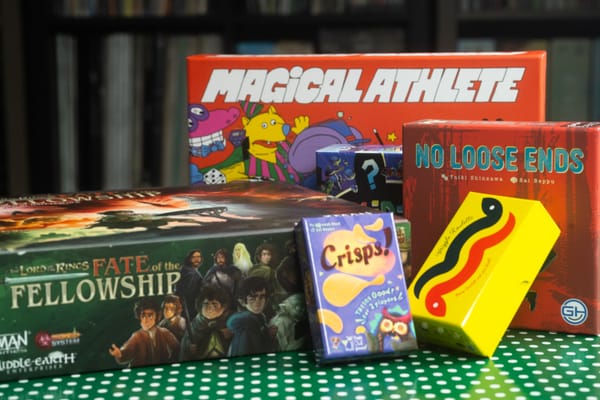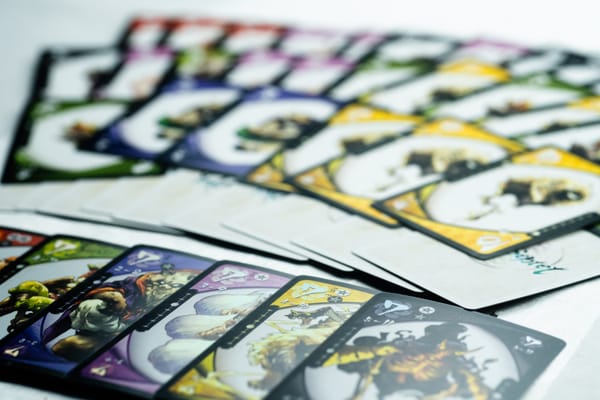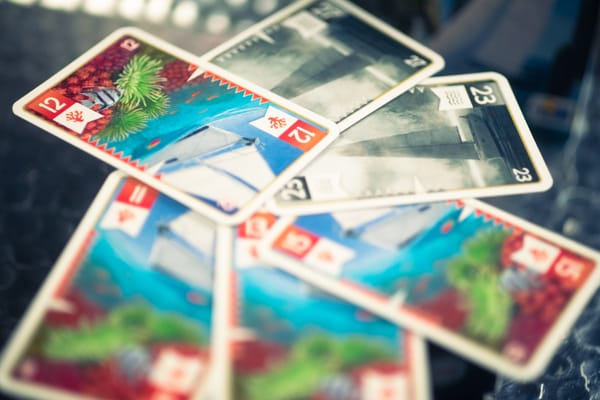Taiki Shinzawa, trick-taking innovator
Few people have pushed trick-taking in new directions quite like Taiki Shinzawa. Let's explore his catalog together.

There’s something innately interesting about a great game designer, about somebody whose hits outweigh their misses, often by a significant margin. There’s something exciting about a game designer who specializes in a field, a person looking for the differences around the edges and expanding the design space in which a mechanism operates.
Taiki Shinzawa is one such designer. His designs that are most readily available have focused on trick-taking and climbing games, and through that lens, he’s been at the forefront of some interesting trends in the genre. Whether it’s the rankless suits in Maskmen (2016), the limited information in luz (2014), or the card back play of Fives (2022), Taiki Shinzawa has established himself as one of the great innovators in the field.
Today, we’re going to go through his games chronologically, focusing closely on some particular highlights in his catalog.
We’ll start with a few games that many have never played, myself included. 2012 sees four games from Taiki.
- Cowardly Bat (2012) is an Oink-published game, but it’s hard to come by. It’s not particularly well-reviewed, but it’s a bluffing game with bats, beasts and birds.
- Binbou-Tougeika/Poor Potter (2012) is an auction game with actual clay and an electronic scale. Interesting, but it’s definitely the sort of game that wouldn’t see wide publication. That’s a tough sell.
- Time Capsule (2012) is another auction game, and I know very little about this one. Rand., designer of the trick-taking and climbing games Tall Tales (2023), Live Evil (2024) and Beychella (2024), described it in a BGG review: “A straightforward auction game with an odd card distribution and charming theme. Not enough going on to keep me around though.” Fair.
- Rakugaki Puranetto (2012) is apparently a line-drawing game? It has no ratings on BGG, no reviews, and only four people list the game as one they own, two of which are deep in the trick-taking community.
An Oink game is certainly nothing to sniff at today, but this is 2012, and the publisher hadn’t yet hit it big with Dungeon of Mandom (later, Welcome to the Dungeon) (Hiraoka and Uesugi, 2013) and Deep Sea Adventure (Sasaki and Sasaki, 2014). We will revisit Oink again in 2014, but first, we’ll look at 2013.
- JELLY! (2013) is actually seven card games in one box, one of which is a climbing game, apparently.
- Lua Cheia (2013) is Taiki’s first recorded trick-taking game. It’s a may-follow trick-taker for two players, and each player has a six-card hand. There’s a fair amount of weirdness going on, which is sort of a great indicator for what’s going to come in 2014.
- TOPPEN (2013) is an abstract strategy game with just ten tiles.
So, 2013 is a bit quiet compared to what you’d expect from the great Taiki Shinzawa, and certainly there could be some interesting games in the catalog here, but there’s nothing that made its way to anything approaching the broader games ecosystem. It’s hard to say if they saw any real success in gaming communities in Japan, as I’m not as tuned into that as some. Still, none of them even have a cult following, and we’ll see with some games coming up here that there’s plenty of that to go around later. Cue 2014.
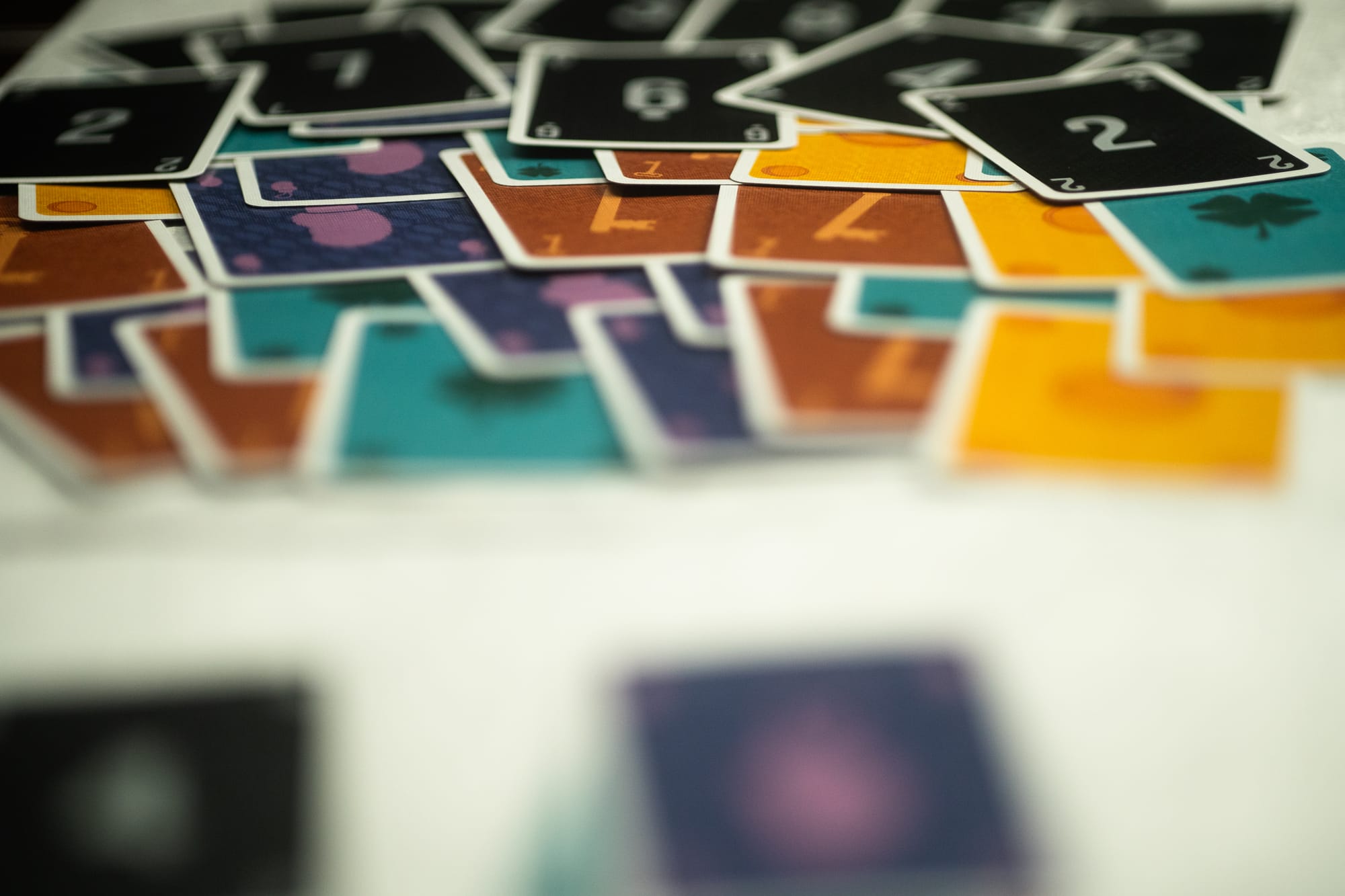


Charms, luz and Maskmen | Photos by Matt Montgomery
- Charms (2014), originally released in 2014 as Dois, splits ranks and suits into two separate decks. Each player starts the round by playing both a rank and a suit, then subsequent tricks see players playing either a rank or a suit, covering the other type of card they already have out. It’s a must-follow game, so you might end up having players forced to play suit cards when they’d really rather not. It’s a wild little game.
- luz (2014) is a trick-taking game in which you don’t see the face of your own cards, just the reverse — and thankfully, you can see the suit you’re playing. You can, however, see everyone else’s cards, so you’re put in a situation where you’ll need to use some deductive logic to figure out what you have in your own hand. It sort of takes the artifice of Hanabi (Bauza, 2010) and turns it into a competitive trick-taking game. This one got a reprint as LUZ (2024), with the biggest difference being that the newer edition supports five players.
- Maskmen (2014) was a real success: It’s a climbing game in which the cards are just suits with no ranks, and the relative priority of the suits changes based on the order in which cards are played in a trick. If a suit hasn’t yet been given a priority, you can beat a played card by playing more cards. It’s such an interesting design, and just like luz and Dois, it holds up really well these 11 years later.
- SILK HAT (2014) — I know nothing about this game. I think it might be in a game book.
2014 becomes a watershed year for Taiki Shinzawa’s designs. Three of these games have seen significant longevity, recent reprints, and sustained success. They played a role in influencing later trick-taking designs. 2015 is sort of the opposite, but it does continue the trick-taking theme.
- 9 Lives (2015), first published as Catty, also features the card suit on the rear, but unlike luz, you can see the face of your cards. You’ll set a bid at the beginning of each round for the number of tricks you’ll win, but the bid can be flexible. You earn points if you hit your bid. I’ve still somehow never played 9 Lives, but it’s on my short list — especially now.
- dados (2015) is a four-player team-based trick-taker where you don’t have cards, you have dice.
- Mantel (2015) looks interesting — it’s a three-player trick-taker in which each player gets identical rank cards, but the suits are represented by colored cubes you're given randomly at the start of the game.
- Player’s Play (2015) looks absolutely fascinating — basically, it’s for four or five players, and each round, players will look at their cards and determine if they want to participate in the game for the round. It might be set collection, blackjack, trick-taking — that sort of thing — based on the number of players that want to participate. I’d love to play this someday, though the odds are very slim.
2016 is a quieter year; 2017 sees no published (at least as we see on BGG) games from Taiki Shinzawa. 2018 is quiet, too.
- TRES (2016) is an abstract strategy game. I don’t know much about it.
- Tower Chess (2016) is a chess variant, and instead of capturing pieces, you stack your piece atop other pieces — and you can stack on top of your own pieces, too. Huh!
- NLT (2018) is a puzzle game with Tetris-style pieces (minus the line piece). You’re trying to build shapes shown on cards. Looks fun enough.
After a quiet three years, Taiki Shinzawa roared back onto the scene in 2019.

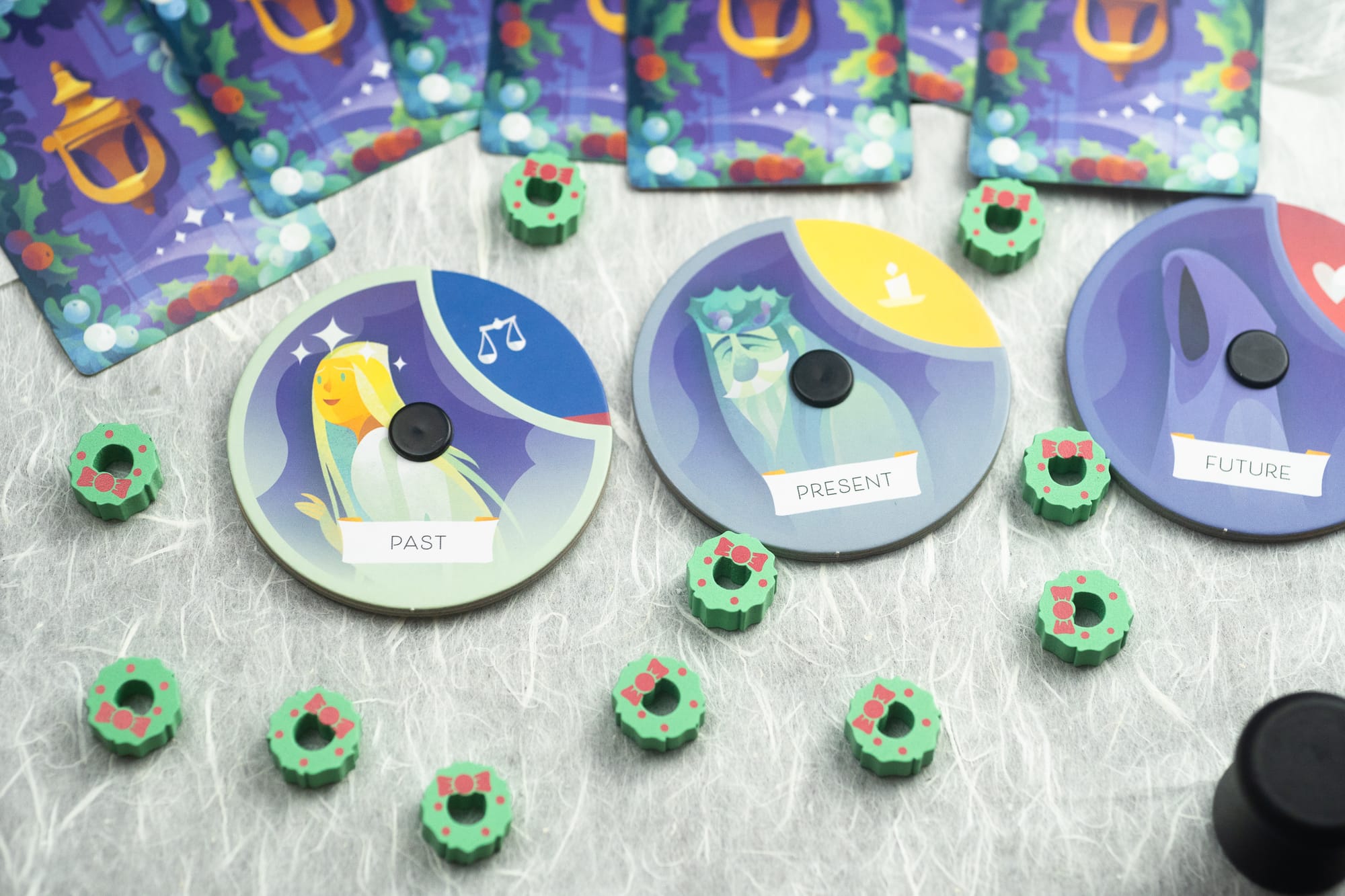

Inflation, Ghosts of Christmas and American Bookshop | Photo by Matt Montgomery
- Time Palatrix (2019), later rethemed as Ghosts of Christmas (2022), has three consecutive tricks to which players are playing in an order they choose. The first player to play to a specific trick sets the suit, and it’s must-follow. And you’ll be bidding. I like this one a lot, and the fact that each player is playing to each trick once gives this one a fresh feel from something like Monster Trick (zur Linde, 2015).
- Zimbabweee Trick (2019), later rethemed as Inflation! (2024), is a trick-taking game of a sort — players must follow the led rank (there are no suits here), and the card they play is used to make an increasingly large number in front of them. Let’s use an example here: I played a 5 the first trick, then a 9 the second trick. My number being evaluated in the second trick is now 95. It continues thusly. It’s definitely not what you’d expect from a trick-taker, but it uses the mechanics around must-follow to create a really interesting game.
- American Bookshop (2019) is a must-follow trick-taker with an unusual rule: Not every player will necessarily have an opportunity to play to a trick, because once the sum of the ranks in the trick exceeds an amount set by the player count (somewhere between 14 and 17), the trick ends, and the player who played the last card takes it. If it doesn’t exceed at any point, the player with the highest on-suit card takes it. Simple enough, but each card you take docks you a point — and you only get positive points by being the player who has taken the most cards in a suit at the end of the round. It’s a clever little game.
- Cinderella’s Dance (2019) is a very light two-player trick-taker (maybe?) with a suitless deck numbered 1 to 21. Play alternates between the two players, each playing a card between 1 and 3 ranks higher than the one last played, and if your opponent passes, you win the trick. Your goal is to win more tricks than your opponent. It’s an extremely simple game designed for an event in Japan called “Is This a Trick-Taking Game?”, which I love the idea of so much. Here’s a blog from somebody in Japanese about the event — you’ll need to use a translator of some sort. It’s funny, though — did you know Zimbabweee Trick was also debuted at this competition, apparently? That’s an interesting little tidbit I didn’t know before now.
2020 continued the trend with two well-regarded designs. I somehow haven’t played either of them, which is a real shame, because I’ve had some good opportunities to do so.
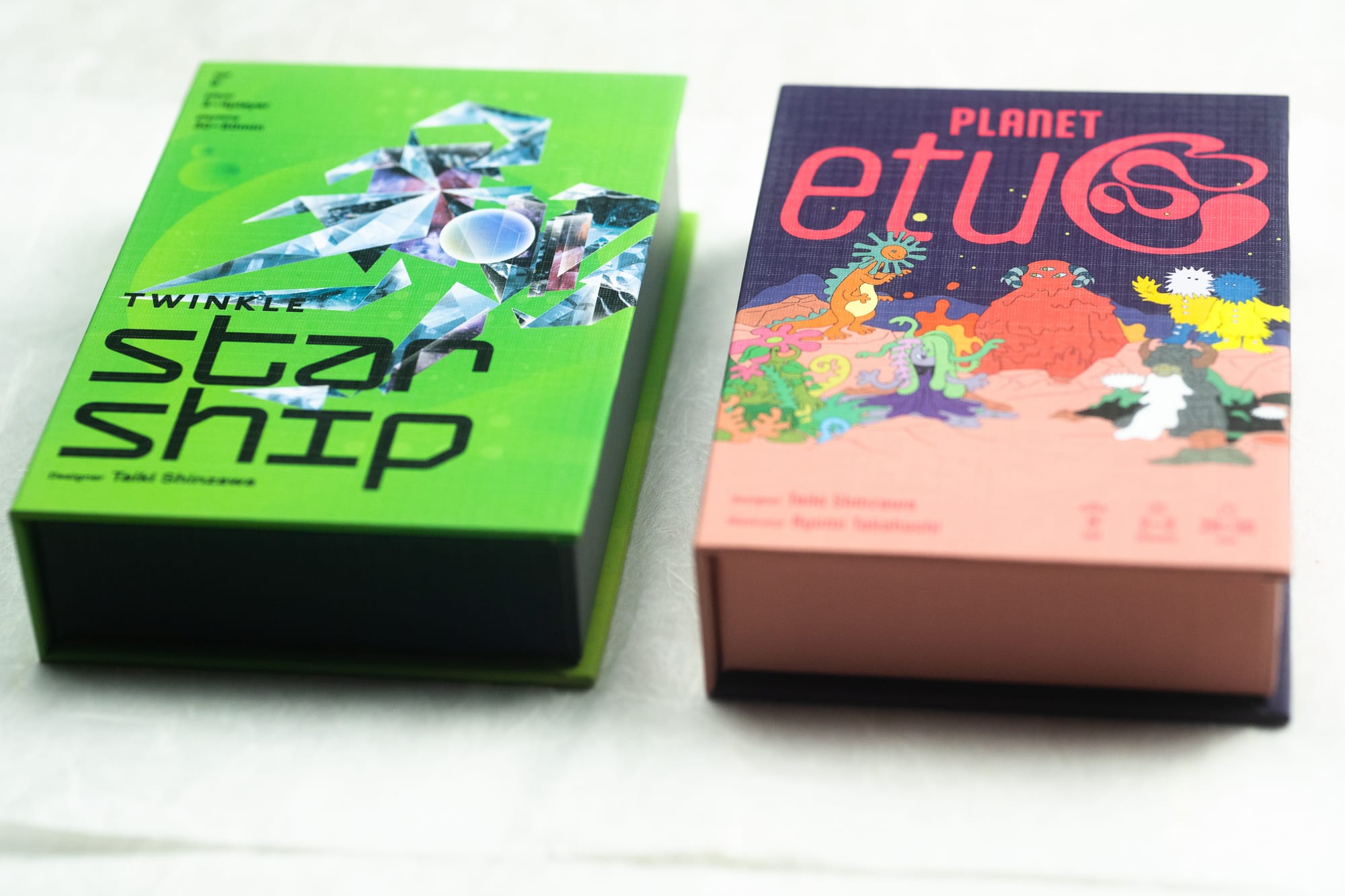
- Ambiente Abissal (2020), later released as Planet etuC (2023), is a climbing game for two or three players that has had real cult success in the trick-taking and climbing scenes. It’s another one of Taiki’s games with disjoint ranks and suits, and both sets have orders of strength.
- §egment Trix (2020), later Twinkle Starship (2023), is a game that’s taught me about ‘seven-segment’ displays, which are just those old digital clocks of various sorts, really. (Oh, and calculators. And a bunch of other things.) It comes with some little sticks (segments!), and the ranks on cards are in the seven-segment style. I don’t know how I haven’t played this yet. It seems like a great time.
2021 proved to be a yea that was a bit quieter again, which is perhaps reasonable after five incredible games in two years. Of these four games, only one has had any impact on Board Game Geek, and it’s the one that eventually saw a reimplementation.
- A World Where Everything is a Little Kinder (2021) is apparently push-your-luck game themed after a manga of the same name.
- Murder Dual: The Elephant in the Courtroom (2021) looks to be a two-player deduction game that apparently you can only play once? Hmm.
- Suroboruos (2021) is an auction game that was later reimplemented as Big Top (2023). We’ll get back to this one later.
- Saifu Aisu (2021) is a Japanese word game. That’s about all I can tell you. It looks nice!
We’re getting closer to current day, hitting 2022 here, and the hits keep coming. It’s clear Taiki Shinzawa is doing really interesting work, and while not everything hits (see also: 2021), there are so many incredible games here, and we’re not yet done. (Nor, I would hope, is the designer himself.)

- The Green Fivura (2022) is a top-in-class trick-taker that enjoyed critical success for a long time, despite very limited availability. CMYK changed that equation this year with their release of the game as Fives. The gameplay remains the same: The reverse of every card features a five (green in the original, magenta in the rerelease), and you can play your cards as those fives. Only one player can do so in a trick, and you still must follow the lead if you’re able. It can be a really interesting way to short suit. This is one of Taiki Shinzawa’s more readily approachable trick-takers, but it still has enough of a twist to keep play on the unusual side.
- COMBO TRAX (2022) is sort of a take on fighting games in a climbing-game form — and it sure seems a bit weird.
- Pin Combi Trio (2022) is a climbing game wit three types of sets to play: singles (“pin”), two consecutive cards (“combi”), or three cards with the same difference — e.g., 2-4-6, 3-12-21, that sort of thing (“trio”). I haven’t played this one yet, but I think that’s really interesting.
Up to this point, we haven’t seen a reimplementation of one of Taiki’s games in the list — notably one that’s not just a retheme, but includes some substantive change as to warrant a new game on BGG. (It’s not the best criteria, but it’s what we’ve got.) Those criteria might just include an adjustment to player count, or it might be a major gameplay change otherwise.
- Big Top (2023) is the reimplementation to which I referred: It reimplements Suroboruos. This is an auction game where bidding can get you points, even if you don’t win. I’d actually really like to sit down and play this one some time. It’s just right there waiting for me.
- Capital Horse (2023) is a trivia game about Japan. I’d be terrible at it. Oh, and it’s a bidding game, too.
- Shihou Dealer (2023) is a trick-taking game (surprise!) that I haven’t played, and honestly, I don’t think I have fully understood it yet from the BGG description. Something about variable suit and rank distributions. Sounds neat.
It’s easy to look at 2024 and see the best year of Taiki Shinzawa’s games on record, with two fairly substantial underground successes in play, as well as a reimplementation of one his more successful efforts. But we’ve only just talked about 2014 and 2019, both of which featured some long-lasting successes. We’ll see what the future holds for these games, but as of right now, two of the mare still hot commodities.
- LUZ (2024) is a fairly straightforward reimplementation of luz (2014), different largely in that it supports five players.
- Shut the Books (2024) is one we’ll talk about in the next section as No Loose Ends (2025) — the game’s basically the same, but there are some differences that push it into a new BGG entry, and thus, for all practical purposes, a new game. (And notably, I’ve played No Loose Ends.)
- 6 Forces (2024) is a trick-taker where the trump suit rotates based on the lead player, but you’re also bidding for trump suit at the start of the round, as well as for the number of tricks you’ll win. This has felt like a real indie hit, and it’s definitely on my list to play — though I might have to proxy it to have the opportunity.
- Color Chord (2024) is the one game this year that I don’t know much about. I suspect I’m not alone. It’s apparently a card battler where you goal is to play the same number as other players? I’m not sure, really.
2025. Here we are. The present day. We’ve got a bigger games here — Quattro Trick-Taking and Quashars are both relatively substantial hits in the trick-taking community — and a reimplementation of the far-too-difficult-to-find Shut the Books. Will we see another game this year? Perhaps! Four seems to be about Taiki Shinzawa’s upper limit, so I wouldn’t expect more than one or two at a stretch.


No Loose Ends and Quattro Trick-Taking | Photo by Matt Montgomery
- Quattro Trick-Taking (2025) takes four different bidding concepts and assigns them to each of the four players in the game, and each round, the bidding concepts rotate around the table. Over four rounds, you’ll have seen each style and accumulated some points. It’s a bit weird, but it’s also Taiki Shinzawa. What’d you expect?
- No Loose Ends (2025) is a reimplementation of Shut the Books with some minor differences, aside from a completely new theme (it’s now about planning and executing a heist, rather than about magical books you need to shut). The basic idea here is that you’ll be bidding with up to three cards from your hand, and to meet the bid, you have to win with either the suit or rank of the card with which you bid. If you win fewer tricks or more tricks, you won’t get nearly as many points. It’s pretty cool.
- Quashars (2025) seems a bit of a mystery to me, as I think I get what the game is doing, but I’m not sure. So, grain of salt here. Basically, it seems that each trick you win can fulfill multiple conditions, and you’ll bid for the number of times you’ll meet conditions in the round. Hah. I’d love to play this one.
- Mirianth Pets (2025) is a forthcoming reimplementation of Ambiente Abissal and Planet etuC. I’m not sure what the differences are here.
And there you have it: Taiki Shinzawa’s catalog discussed in total. I’ve played a surprising number of his games, as I thought I’d played a bit fewer, but that’s exciting. I’d love to play more of them, and I know it’s still kind of unbelievable I’ve never played Ambiente Abissal. I’ll get on that.


